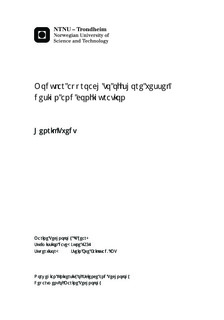| dc.contributor.advisor | Erikstad, Stein Ove | nb_NO |
| dc.contributor.author | Tvedt, Henrik | nb_NO |
| dc.date.accessioned | 2014-12-19T12:07:29Z | |
| dc.date.available | 2014-12-19T12:07:29Z | |
| dc.date.created | 2012-11-08 | nb_NO |
| dc.date.issued | 2012 | nb_NO |
| dc.identifier | 566095 | nb_NO |
| dc.identifier | ntnudaim:7709 | nb_NO |
| dc.identifier.uri | http://hdl.handle.net/11250/238192 | |
| dc.description.abstract | The design process used in most vessel design approaches can be described as sequential and iterative, where the initial design is subject to constant improvements. The process development is thereby constrained by the decisions made in early stages of design. It becomes apparent that the more design knowledge which can be generated and evaluated in these stages, the better foundation the designer has to make the best decisions. System Based Ship design (SBSD) has introduced a bottom-up approach which generates a functional description based on the vessel missions for use in early stages of design. SBSD focuses on enabling creativity and innovation in vessel design by being able to evaluate alternative solutions. The increase and availability of computational processing capacity these days is a contributor to enabling more design aspects included in earlier design stages.This thesis focuses on development of a system that is able to efficiently develop and evaluate Offshore Support Vessel designs and alternative designs in concept- and preliminary stages of design. Based on the functional description of OSVs from the SBSD methodology are modules related to vessels missions systematically identified and generated. Modular Product Platforms (MPPs) which contains rules for how these OSV modules can be combined have been developed to efficiently develop design alternatives for consideration. The main focuses have been to enable creativity, innovation and alternative solutions in an efficient manner in early stages of design. Due to the physical similarities that the OSVs share, MPPs have provided a good tool for efficient development of these vessels. The parametric ship description within the MPPs enables concept exploration and improvement with low effort and facilitates design evaluation and improvement. Automated 3D modelling based on the OSV MPPs provides a more intuitive design process and facilitates design evaluation to multiple vessel alternatives. The responsiveness and flexibility of the MPP and automated 3D modelling is believed to have benefits in a sales situation to efficiently develop design alternatives based on customer demands and providing a visual representation for discussion. This has the potential of reducing the time and resources involved in tendering/sales projects. MPPs can be used by design companies to more easily communicate which designs they can offer, and to explore vessel design parameters influence on performance. Due to vessels complex hull shape, the modules shapes and quantity positioned within the hull influence the performance of the output design form the MPPs. Control and manipulation of hull shape is found to be essential due to vessel characteristics. Sectioning of the hull shapes within the MPPs has provided a good method of enabling control and evaluation of the hull shape with minimum compromise to other design performances. Databases containing vessel statistics have provided a good method of comparing key performance criteria of output design from the MPPs to existing vessels and thereby contribute to validation of the design. These vessel statistics will also support the designer in providing good initial input values for parameters that are found by iterations and design development. Search- and optimization algorithms can be used to find good configurations of the MPP parameters and support the designer with parameter options in future developments. The developed MPPs can be further developed to incorporate more aspects to OSV design, and by supporting and incorporating analysis and simulations from other software applications, based in the generated 3D model, a solid tool for OSV design can be established. Re-configuration related to OSV operations can become a solution in competition for the most favourable contracts and to account for the fluctuating and seasonal market. Re-configuration alternatives can efficiently be launched and evaluated by the use of MPPs. Although the developed system seems to efficiently develop design alternatives with good performance, it has yet to prove its applicability as a tool for use in the industry. | nb_NO |
| dc.language | eng | nb_NO |
| dc.publisher | Institutt for marin teknikk | nb_NO |
| dc.subject | ntnudaim:7709 | no_NO |
| dc.subject | MIMART Marin teknikk (2 årig) | no_NO |
| dc.subject | Marin prosjektering | no_NO |
| dc.title | Modular approach to offshore vessel design and configuration | nb_NO |
| dc.type | Master thesis | nb_NO |
| dc.source.pagenumber | 103 | nb_NO |
| dc.contributor.department | Norges teknisk-naturvitenskapelige universitet, Fakultet for ingeniørvitenskap og teknologi, Institutt for marin teknikk | nb_NO |

